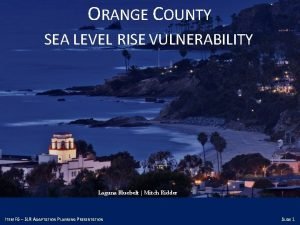Radon Occurrence in Groundwater in Orange County Radon

- Slides: 1

Radon Occurrence in Groundwater in Orange County Radon, a colorless, odorless gas, occurs naturally and has been detected in well water samples and in the air of some homes in Orange County. Radon is the second leading cause of lung cancer in the United States after smoking. When radon decays after it is inhaled, the resulting radioactive particles can damage lung cells and cause lung cancer. The most common route of exposure to radon is through breathing indoor air which contains radon. Radon in water can also be a source of exposure if your water supply is groundwater, especially if the underlying bedrock contains granite, which can produce higher concentrations of radon gas than other types of bedrock. In 1991 the U. S. Environmental Protection Agency (EPA) proposed a Maximum Contaminant Level (MCL) for radon in drinking water of 300 picocuries per liter (p. Ci/L), and an alternative MCL (AMCL) of 4, 000 pci/L if a state has adopted a program to address radon concentrations in indoor air. Since neither the MCL or AMCL have been adopted at the Federal level, and since North Carolina has also not adopted regulations governing exposure to radon, these values can possibly be used as advisory or action levels. The EPA recommends that all homes be tested for indoor air radon content. If you utilize water from a private well, you may also want to have your water tested for radon. If you would like to find out how to have your indoor air or well water tested for radon content, contact the Orange County Health Department, Environmental Health Services at 919 -245 -2360. Radon Concentrations in Groundwater (picocuries/liter- p. Ci/L) Radon detected below the proposed MCL of 300 p. Ci/l Radon detected between 300 p. Ci/l and 3, 999 p. C/l (above proposed MCL and below alternative MCL) Radon detected equal to or above alternative MCL of 4, 000 p. Ci/l Data Sources: Radon in groundwater data from 1998, 1999 and 2001 sampling events and from the North Carolina Department of Environment and Natural Resources - Division of Water Quality and the United States Geological Survey. Cunningham, W. L. and Daniel, C. C. , 2001, Investigation of Ground-Water Availability and Quality in Orange County, North Carolina: U. S. Geological Survey Water-Resources Investigations Report 00 -4286, 59 p. Acknowledgements: County map with radon data provided by North Carolina Geological Survey.

